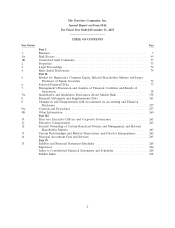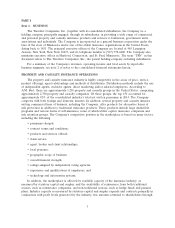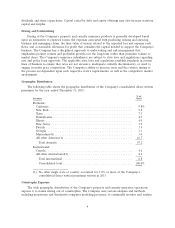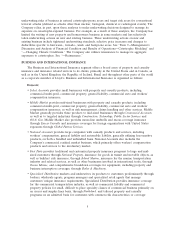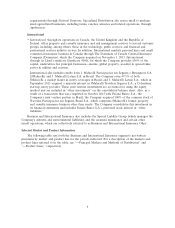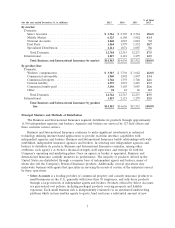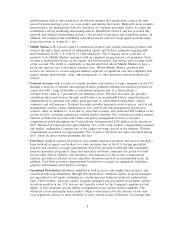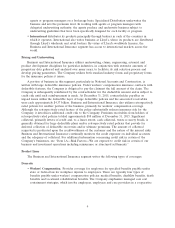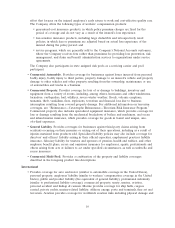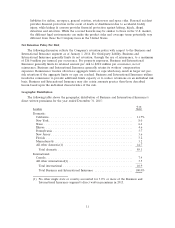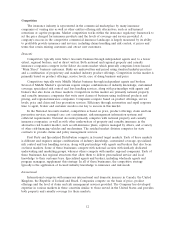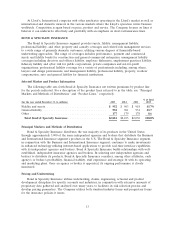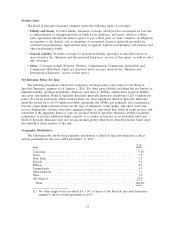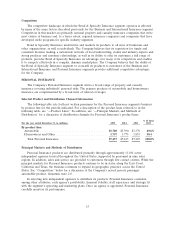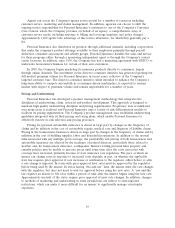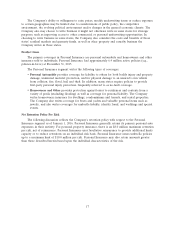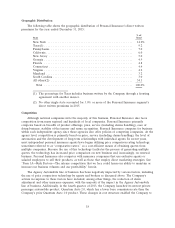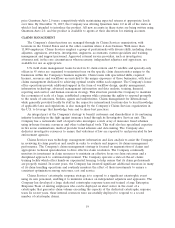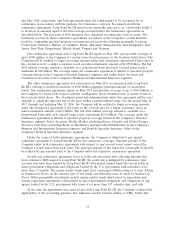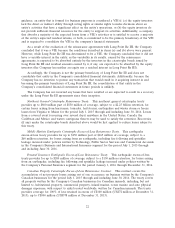Travelers 2015 Annual Report Download - page 12
Download and view the complete annual report
Please find page 12 of the 2015 Travelers annual report below. You can navigate through the pages in the report by either clicking on the pages listed below, or by using the keyword search tool below to find specific information within the annual report.Competition
The insurance industry is represented in the commercial marketplace by many insurance
companies of varying size as well as other entities offering risk alternatives, such as self-insured
retentions or captive programs. Market competition works within the insurance regulatory framework to
set the price charged for insurance products and the levels of coverage and service provided. A
company’s success in the competitive commercial insurance landscape is largely measured by its ability
to profitably provide insurance and services, including claims handling and risk control, at prices and
terms that retain existing customers and attract new customers.
Domestic
Competitors typically write Select Accounts business through independent agents and, to a lesser
extent, regional brokers, and as direct writers. Both national and regional property and casualty
insurance companies compete in the Select Accounts market which generally comprises lower-hazard,
‘‘Main Street’’ business customers. Risks are underwritten and priced using standard industry practices
and a combination of proprietary and standard industry product offerings. Competition in this market is
primarily based on product offerings, service levels, ease of doing business and price.
Competitors typically write Middle Market business through independent agents and brokers.
Several of Middle Market’s operations require unique combinations of industry knowledge, customized
coverage, specialized risk control and loss handling services, along with partnerships with agents and
brokers that also focus on these markets. Competitors in this market are primarily national property
and casualty insurance companies that write most classes of business using traditional products and
pricing, and regional insurance companies. Companies compete based on product offerings, service
levels, price and claim and loss prevention services. Efficiency through automation and rapid response
time to agent, broker and customer needs is one key to success in this market.
In the National Accounts market, competition is based on price, product offerings, claim and loss
prevention services, managed care cost containment, risk management information systems and
collateral requirements. National Accounts primarily competes with national property and casualty
insurance companies, as well as with other underwriters of property and casualty insurance in the
alternative risk transfer market, such as self-insurance plans, captives managed by others, and a variety
of other risk-financing vehicles and mechanisms. The residual market division competes for state
contracts to provide claims and policy management services.
First Party and Specialized Distribution compete in focused target markets. Each of these markets
is different and requires unique combinations of industry knowledge, customized coverage, specialized
risk control and loss handling services, along with partnerships with agents and brokers that also focus
on these markets. Some of these businesses compete with national carriers with similarly dedicated
underwriting and marketing groups, whereas others compete with smaller regional companies. Each of
these businesses has regional structures that allow them to deliver personalized service and local
knowledge to their customer base. Specialized agents and brokers, including wholesale agents and
program managers, supplement this strategy. In all of these businesses, the competitive strategy
typically is the application of focused industry knowledge to insurance and risk needs.
International
International competes with numerous international and domestic insurers in Canada, the United
Kingdom, the Republic of Ireland and Brazil. Companies compete on the basis of price, product
offerings and the level of claim and risk management services provided. The Company has developed
expertise in various markets in these countries similar to those served in the United States and provides
both property and casualty coverage for these markets.
12


